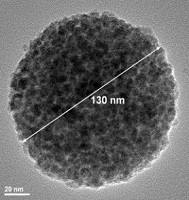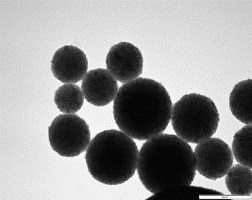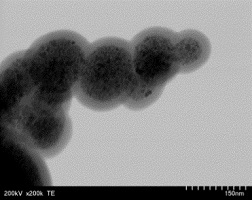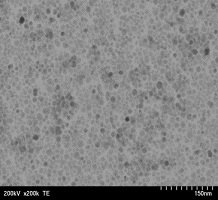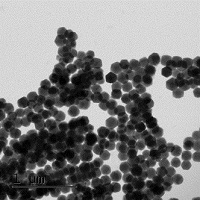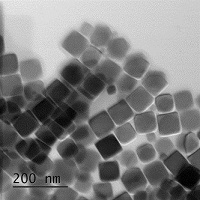Echipa CDI Materiale multifuncționale și compuși biologic activi are expertiză în domeniul materialelor avansate și desfășoară activități de cercetare ce vizează obținerea, caracterizarea și testarea aplicațiilor nanostructurilor hibride funcționalizate, materialelor polimerice și a compușilor bioactivi cu proprietăți controlate.
Tematici de cercetare:
- Nanostructuri hibride funcționalizate pe baza de nanoparticule magnetice și compuși organici
- Micro/nanogeluri magnetice inteligente pentru aplicaţii în biotehnologii şi nanomedicină
- Nanoparticule magnetice și clusteri magnetici cu proprietăți controlate pentru aplicații în separare magnetică, depoluare, nanomedicină și securitate
- Noi polimeri/ copolimeri cu proprietăți speciale pentru aplicații în industria farmaceutică și medicină
- Caracterizarea complexă a materialelor multifuncționale: corelația nanostructură-proprietăți, proprietăți responsive la stimuli externi, interacții specifice cu biomolecule și anumite medicamente, reciclabilitate (spectroscopie de fotoelectroni cu excitare raze X (XPS), spectroscopie FTIR, spectroscopie Raman; spectroscopie EELS); determinarea poziţiei în scală absolută (faţă de vacuum) a benzilor de valenţă şi conducţie cu ajutorul metodelor XPS, UPS şi UV-vis la nanoparticule semiconductoare
- Sinteză de nanomateriale cu proprietăți controlate, utilizând reactivi prietenoși față de mediu
- Nanoparticule magnetice și structuri de carbon modificate cu oxizi metalici – sinteză și caracterizare. Aplicații în depoluare și medicină
- Extracția și caracterizarea compușilor bioactivi din plante
- Îmbunătățirea calității produselor cosmetice utilizând extracte naturale din plante cu proprietăți antioxidante și fotoprotectoare
- Utilizarea extractelor din plante pentru îmbunătățirea calității produselor alimentare
- Aplicații ale nanomaterialelor și ale compușilor bioactivi pentru depoluare
- Aplicații ale metodelor cromatografice (HPLC, TLC) și spectrofotometrice (UV-Vis) în analiza poluanților din mediul înconjurător și determinarea calității medicamentelor, calității produselor alimentare, purității compușilor organici și organo-metalici sintetizați
- Determinarea influenţei factorilor de stres asupra dezvoltării plantelor şi compuşilor bioactivi din plante
Șef Echipă
Dr. Alexandrina Emilia NAN – Cercetător principal (R4) – CS I
Domeniu de expertiză: Știinţa şi ingineria materialelor şi nanomaterialelor, Chimie organică.
Membri:
Dr. Alexander BUNGE – Cercetător recunoscut (R2) – CS III
Domeniu de expertiză: Chimie organică, Sinteză chimică, Chimia materialelor.
Ing. Anda-Maria CHIȘ – Asistent de cercetare științifică – ACS
Domeniu de expertiză: Pregătirea probelor pentru analiză prin cromatografie de lichide de înaltă performanță (HPLC), Înregistrare și interpretare cromatograme în spectrofotometrie UV-Vis.
Dr. Izabell CRĂCIUNESCU – Inginer de Dezvoltare Tehnologică II
Domeniu de expertiză: Chimia materialelor, Electrochimie.
Dr. ing. Melinda-Éva GAL – Cercetător debutant (R1) – CS
Domeniu de expertiză: Sectroscopie de florescență, Sectroscopie de IR.
Drd. ing. Iolanda Veronica GANEA – Cercetător debutant (R1) – CS
Domeniu de expertiză: Știința și Ingineria Mediului, Ecotoxicologie, Managementul riscurilor și dezastrelor naturale/tehnologice, Decontaminarea solurilor și a apelor, Analiza integrată a sedimentelor.
Dr. George-Marian ISPAS – Cercetător debutant (R1) – CS
Domeniu de expertiză: Știința mediului.
Prof. Dr. Jürgen LIEBSCHER – Cercetător principal (R4) – CS I
Domeniu de expertiză: Chimie Organică, Chimia heterociclurilor, Chimia polidopaminei, Nanostructuri magnetice, Organocatalizǎ, Lichide ionice, Analogi ai produşilor naturali, Conjugate lipide – acizi nucleici.
Dr. Ildiko LUNG – Cercetător recunoscut (R2) – CS III
Domeniu de expertiză: Chimie analitică, Știința mediului, Nanomateriale.
Dr. Dana-Emanuela LUSHNYKOV – Asistent de cercetare științifică – ACS
Domeniu de expertiză: Biochimie, Biotehnologie, Biologie vegetală, Ştiinţa mediului.
Ildiko MACAVEI – Tehnician senior (TS)
Dr. Ocsana Ileana OPRIŞ – Cercetător consacrat (R3) – CS II
Domeniu de expertiză: Chimie, Chimie analitică, Cromatografie, Ştiinţa mediului.
Dr. Anca Cristina PETRAN – Cercetător consacrat (R3) – CS II
Domeniu de expertiză: Chimia polimerilor, Chimie organic, Materiale compozite.
Dr. Stelian Gheorghe PINTEA – Cercetător recunoscut (R2) – CS III
Domeniu de expertiză: Fizica materialelor, Fizica suprafețelor și interfețelor.
Dr. Mircea Nicolae POP – Cercetător recunoscut (R2) – CS III
Domeniu de expertiză: Electronică – analiză și proiectare, Sisteme încorporate cu microcontroller sau FPGA, Fizică experimentală, Calorimetrie- teorie și experiment, Instrumentație de măsură și monitorizare.
Dr. Teodora Maria RADU – Cercetător consacrat (R3) – CS II
Domeniu de expertiză: Ştiinta materialelor, Spectroscopie: XPS, UPS, EELS.
Dr. habil. Maria Loredana SORAN – Cercetător principal (R4) – CS I
Domeniu de expertiză: Chimie analitică, Știința mediului, Știința plantelor, Nanomateriale.
Dr. Olimpia Adina STEGĂRESCU – Cercetător consacrat (R3) – CS II
Domeniu de expertiză: Chimie.
Dr. Natalia TERENTI – Cercetător debutant (R1) – CS
Domeniu de expertiză:Sinteza și caracterizarea compușilor coordinativi, Sinteza organică, Spectroscopie UV-Vis și fluorometrie (solitie, film, solid) Voltametrie ciclica, Cataliza eterogena.
Dr. Rodica Paula TURCU – Cercetător principal (R4) – CS I
Domeniu de expertiză: Știinţa materialelor, Nanomateriale, Fizica stării solide.
Poly(benzofurane-co-arylacetic acid) – a new type of highly functionalized polymers
 4-Hydroxymandelic acid a typical α-hydroxy acid was polymerized by thermal treatment. Surprisingly, instead of the commonly observed polyester formation (e. g. in case of lactic or glycolic acid), C-C-bond connection between the phenolic units of 4-hydroxymandelic acid, by Friedel-Crafts alkylation, occurred resulting in polymers containing carboxylic and phenolic moieties. In addition, lactone formation by reaction between phenol and carboxyl groups in appropriate positions took place leading to benzofuranone units in the final polymer. Thus, poly(benzofurane-co-arylacetic acid) structures, a novel type of organic polymer, were obtained. Interestingly, branching of the polymer chain was also detected. Detailed analysis of these polymerized 4-hydroxymandelic acids (PHMA) by spectroscopic methods revealed formation of oligomers up to 15-mers. Moreover, the three reactive units (acid, phenol, lactone) in the structureof PHMA provide orthogonal reactivity: i) lactone rings reacted with 7-amino-4-methylquinolin-2(1H)-one by amide bond formation. ii) phenol groups were O and/or C-propargylated by reaction with propargyl bromide. iii) Propargylated as well as unmodified PHMA were used as coating for magnetite nanoparticles by Steglich esterification exploiting the carboxyl reactivity of the PHMA. Propargylated products were submitted to CuAAC click reaction in order to link functions of potential practical interest in nanomedicine and organocatalysis. The extreme easiness of preparation and the widespread reactivity render PHMA attractive for many applications.
4-Hydroxymandelic acid a typical α-hydroxy acid was polymerized by thermal treatment. Surprisingly, instead of the commonly observed polyester formation (e. g. in case of lactic or glycolic acid), C-C-bond connection between the phenolic units of 4-hydroxymandelic acid, by Friedel-Crafts alkylation, occurred resulting in polymers containing carboxylic and phenolic moieties. In addition, lactone formation by reaction between phenol and carboxyl groups in appropriate positions took place leading to benzofuranone units in the final polymer. Thus, poly(benzofurane-co-arylacetic acid) structures, a novel type of organic polymer, were obtained. Interestingly, branching of the polymer chain was also detected. Detailed analysis of these polymerized 4-hydroxymandelic acids (PHMA) by spectroscopic methods revealed formation of oligomers up to 15-mers. Moreover, the three reactive units (acid, phenol, lactone) in the structureof PHMA provide orthogonal reactivity: i) lactone rings reacted with 7-amino-4-methylquinolin-2(1H)-one by amide bond formation. ii) phenol groups were O and/or C-propargylated by reaction with propargyl bromide. iii) Propargylated as well as unmodified PHMA were used as coating for magnetite nanoparticles by Steglich esterification exploiting the carboxyl reactivity of the PHMA. Propargylated products were submitted to CuAAC click reaction in order to link functions of potential practical interest in nanomedicine and organocatalysis. The extreme easiness of preparation and the widespread reactivity render PHMA attractive for many applications.
[1]. A. Nan,* A. Bunge,* M. Cîrcu, A. Petran, N. D. Hădade and X. Filip, Polymer Chemistry, Vol. 8, 3504–3514 (2017)
Clean production of new functional coatings of magnetic nanoparticles from sustainable resources
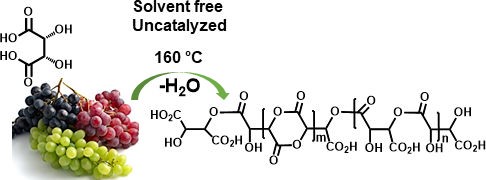 Magnetic nanoparticles coated with functional polymers play an important role in clean ways of catalysis and water treatment as well as in nanomedicine. Known systems either contain only terminal functions or polymers with pendant positively charged groups. Poly(tartaric acid) (PTA) as a new polymer with multiple pendant negatively charged carboxylate groups was pursued useful for coating magnetic nanoparticles. Simple heating of tartaric acid as a sustainable natural product without using a solvent or a catalyst under controlled conditions leads to poly(tartaric acid). The reaction runs in the solid state by elimination of water and traces of carbon oxides. The structure of the resulting poly(tartaric acid) consists mainly of polyester moieties with pendant carboxyl groups and some lactide units. It was elucidated by mass spectrometry, solid-state 13C nuclear magnetic resonance (13C ss-NMR) and Fourier-transform infrared spectroscopy (FTIR). The properties of the products depend in part on the type of starting materials (L-tartaric acid or D,L-tartaric acid). Pendant carboxyl and hydroxyl groups provide hydrophilicity and the possibility to link functions of interest. The PTA was used as new functional coatings for magnetite nanoparticles in a clean way by mixing the components and magnetic separation. The chemical stability of the magnetic nanoparticles covered by PTA was studied by UV-VIS spectroscopy in water for three weeks. Further linkage of amino-containing entities of practical interest was demonstrated by covalently binding of glucosamine.
Magnetic nanoparticles coated with functional polymers play an important role in clean ways of catalysis and water treatment as well as in nanomedicine. Known systems either contain only terminal functions or polymers with pendant positively charged groups. Poly(tartaric acid) (PTA) as a new polymer with multiple pendant negatively charged carboxylate groups was pursued useful for coating magnetic nanoparticles. Simple heating of tartaric acid as a sustainable natural product without using a solvent or a catalyst under controlled conditions leads to poly(tartaric acid). The reaction runs in the solid state by elimination of water and traces of carbon oxides. The structure of the resulting poly(tartaric acid) consists mainly of polyester moieties with pendant carboxyl groups and some lactide units. It was elucidated by mass spectrometry, solid-state 13C nuclear magnetic resonance (13C ss-NMR) and Fourier-transform infrared spectroscopy (FTIR). The properties of the products depend in part on the type of starting materials (L-tartaric acid or D,L-tartaric acid). Pendant carboxyl and hydroxyl groups provide hydrophilicity and the possibility to link functions of interest. The PTA was used as new functional coatings for magnetite nanoparticles in a clean way by mixing the components and magnetic separation. The chemical stability of the magnetic nanoparticles covered by PTA was studied by UV-VIS spectroscopy in water for three weeks. Further linkage of amino-containing entities of practical interest was demonstrated by covalently binding of glucosamine.
[1]. A. Nan*, X. Filip, M. Dan, O. Marinca, Journal of Cleaner Production, Vol. 210, 687-696 (2019)
Magnetic microgels, a promising candidate for enhanced magnetic adsorbent particles in bioseparation
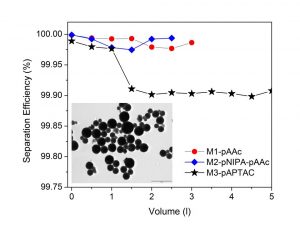 For specific applications in the field of high gradient magnetic separation of biomaterials, magnetic nanoparticle clusters of controlled size and high magnetic moment in an external magnetic field are of particular interest. High magnetization magnetic microgels with superparamagnetic behaviour have been obtained in a two-step synthesis procedure by miniemulsion technique using highly stable ferrofluid on volatile nonpolar carrier. Spherical clusters of closely packed hydrophobic oleic acid coated magnetite nanoparticles were coated with cross linked polymer shells of polyacrylic acid, poly-N-isopropylacrylamide, poly-3 -acrylamidopropyl trimethylammonium chloride. The experiments using High Gradient Magnetic Separator show high values of the separation efficiency (99.9 – 99.97%) for the magnetic microgels.
For specific applications in the field of high gradient magnetic separation of biomaterials, magnetic nanoparticle clusters of controlled size and high magnetic moment in an external magnetic field are of particular interest. High magnetization magnetic microgels with superparamagnetic behaviour have been obtained in a two-step synthesis procedure by miniemulsion technique using highly stable ferrofluid on volatile nonpolar carrier. Spherical clusters of closely packed hydrophobic oleic acid coated magnetite nanoparticles were coated with cross linked polymer shells of polyacrylic acid, poly-N-isopropylacrylamide, poly-3 -acrylamidopropyl trimethylammonium chloride. The experiments using High Gradient Magnetic Separator show high values of the separation efficiency (99.9 – 99.97%) for the magnetic microgels.
[1]. Rodica Turcu*, Vlad Socoliuc, Izabell Crăciunescu, Anca Petran, Anja Paulus, Matthias Franzreb, Eugeniu Vasile and Ladislau Vekas, Soft Matter 11, 1008-1018 (2015)
From high colloidal stability ferrofluids to magnetorheological fluids: tuning the flow behavior by magnetite nanoclusters
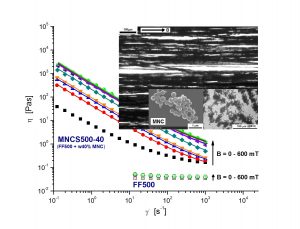 The flow behavior of practically structureless ferrofluids was tuned over a large range by adding well-defined amounts of magnetite nanoparticle clusters. Magnetite nanoparticle clusters with hydrophobic coating were dispersed in high colloidal stability transformer oil based ferrofluid samples, initially free of clusters. The resulting ferrofluid composition consists both of single (approx. 7 nm mean size) and clustered (280 nm average size) magnetite nanoparticles. The magnetite nanoparticle clusters obtained by a solvothermal method have a saturation magnetization of 75 emu g−1 and a remnant magnetization of 0.2 emu g−1 due to the large size (∼25 nm) of the magnetite nanoparticles in their composition. The bidisperse magnetic nanocomposite suspensions investigated provide a promising new formulation of magnetorheological fluids with improved kinetic stability to be used in seismic dampers and flow control devices.
The flow behavior of practically structureless ferrofluids was tuned over a large range by adding well-defined amounts of magnetite nanoparticle clusters. Magnetite nanoparticle clusters with hydrophobic coating were dispersed in high colloidal stability transformer oil based ferrofluid samples, initially free of clusters. The resulting ferrofluid composition consists both of single (approx. 7 nm mean size) and clustered (280 nm average size) magnetite nanoparticles. The magnetite nanoparticle clusters obtained by a solvothermal method have a saturation magnetization of 75 emu g−1 and a remnant magnetization of 0.2 emu g−1 due to the large size (∼25 nm) of the magnetite nanoparticles in their composition. The bidisperse magnetic nanocomposite suspensions investigated provide a promising new formulation of magnetorheological fluids with improved kinetic stability to be used in seismic dampers and flow control devices.
[1]. Daniela Susan-Resiga, V Socoliuc*, A Bunge, Rodica Turcu* and L Vékás, Smart Materials and Structures 28, 115014 (2019)
The efficiency of the multi-walled carbon nanotubes used for antibiotics removal from wastewaters generated by animal farms
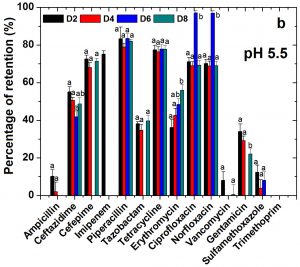
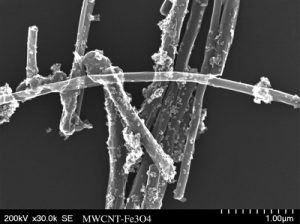 The efficiency of several types of multi-walled carbon nanotubes (MWCNTs) were tested for the retention of the selected antibiotics (ampicillin, ceftazidime, cefepime, imipenem, piperacillin, tazobactam, tetracycline, erythromycin, ciprofloxacin, norfloxacin, vancomycin, gentamicin) from wastewater samples. The retention percentages of the selected antibiotics from waters ranged between ∼40 and 97%. The best percentages of retention were obtained for norfloxacin 97.03% and ciprofloxacin 97.10%. The suspensions of the MWCNTs improved the removal of the antibiotic from wastewaters.
The efficiency of several types of multi-walled carbon nanotubes (MWCNTs) were tested for the retention of the selected antibiotics (ampicillin, ceftazidime, cefepime, imipenem, piperacillin, tazobactam, tetracycline, erythromycin, ciprofloxacin, norfloxacin, vancomycin, gentamicin) from wastewater samples. The retention percentages of the selected antibiotics from waters ranged between ∼40 and 97%. The best percentages of retention were obtained for norfloxacin 97.03% and ciprofloxacin 97.10%. The suspensions of the MWCNTs improved the removal of the antibiotic from wastewaters.
M.L. Soran, O. Opriş, I. Lung, I. Kacso, A.S. Porav, M. Stan, Environ. Sci. Pollut. Res. 2017, 24(19), 16396–16406.
Effect of lipophilic sea buckthorn extract on cream cheese properties

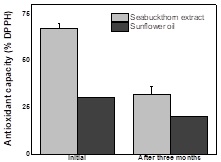 The optimized lipophilic extract of sea buckthorn was added as colorant into the cream cheese. Following the addition of the extract, it was found that the cream cheese was positively influenced by sea buckthorn lipophilic extracts increasing the antiradical activity and inhibiting the growth of the germ in the cream cheese. Moreover, the addition of sea buckthorn extracts did not adversely affect the sensory characteristics of the product. This research demonstrates the possibility of using sea buckthorn lipophilic extract in the production of functional foods. A particular interest is the possibility of replacing synthetic antioxidants with natural ones obtained from local horticultural sources in order to provide consumers with safe and stable food products.
The optimized lipophilic extract of sea buckthorn was added as colorant into the cream cheese. Following the addition of the extract, it was found that the cream cheese was positively influenced by sea buckthorn lipophilic extracts increasing the antiradical activity and inhibiting the growth of the germ in the cream cheese. Moreover, the addition of sea buckthorn extracts did not adversely affect the sensory characteristics of the product. This research demonstrates the possibility of using sea buckthorn lipophilic extract in the production of functional foods. A particular interest is the possibility of replacing synthetic antioxidants with natural ones obtained from local horticultural sources in order to provide consumers with safe and stable food products.
A. Ghendov-Moșanu, R. Sturza, O. Opriș, I. Lung, L. Popescu, V. Popovici, M.L. Soran, A. Patras, J. Food. Sci. Technol., 2019, https://doi.org/10.1007/s13197-019-04094-w.
Magnetic clusters with controlled properties
Autori: Izabell Crăciunescu, Rodica Turcu
Magnetic clusters represent controlled assembly of magnetic nanoparticles with controlled structural, morphological and magnetic properties from the synthesis parameters, which maintain their superparamagnetic properties, having high magnetic moments.
Within our research group we optimized the mini emulsion method in which we obtain assembly of magnetic nanoparticles in the form of clusters with adjustable size in a wide range 50-500 nm, with high magnetic moment, with very good chemical stability and good dispersion properties in liquid media. The synthesis procedure ensures very good reproducibility of magnetic clusters and allows for large scale production. Modifying surface properties by coating with different inorganic or organic polymeric layers, or various molecules with specific functions offers the perspective of using magnetic clusters towards a variety of innovative applications in different fields: bionanotechnologies, health, environment, security. These advanced magnetics nanostructures offer the possibility of new advanced therapeutic, diagnostic or bioprocessing methods controlled both by the applied magnetic field and by an appropriate design of the properties.
Magnetic nanoparticles with size and shape control
Autori: Izabell Crăciunescu, Rodica Turcu
Magnetic nanoparticles with controlled morphology, synthesized by thermal decomposition method of organic precursors of the metals of interest, find their use in applications of great interest in the medical field such as biomagnetic imaging, cancer diagnosis and treatment as well as hyperthermia. Magnetite (Fe3O4) or ferrite (MnFe2O4, ZnFe2O4) nanoparticles can be obtained by rigorously controlling the size and shape with the following improved features:
- adjustable size in the range 10 – 100 nm;
- adjustable shape depending on the target application: spherical, cubic or polyhedral;
- significant improvements of magnetic properties, by increasing the saturation magnetization value;
- easy functionalization possibility of the surface with inorganic / organic, polymeric or biocomposite layers of interest.
-
- Academia Română – Filiala Timișoara, Centrul de Cercetări Tehnice Fundamentale și Avansate, Str. Mihai Viteazu nr. 24, Timișoara
Nanofluide magnetice și materiale compozite magnetoresponsive - Institutul Național de Cercetare-Dezvoltare pentru Fizica Materialelor – INCD FM București, Str. Atomiștilor, nr. 405A, Măgurele, județul Ilfov
Nanostructuri magnetice pentru noi metodologii de diagnosticare și tratament - Institutul Național de Cercetare-Dezvoltare pentru Fizică și Inginerie Nucleară „Horia Hulubei” – IFIN-HH, Str. Reactorului nr. 30, Măgurele, județul Ilfov
Nanoparticule magnetice funcționalizate pentru aplicații în radioendoterapie țintită - C. ROSEAL S.A., Str. Nicolae Bălcescu nr. 5/A, Odorheiu Secuiesc, județul Harghita
Clusteri magnetici cu proprietăți controlate pentru noi aplicații în separare magnetică și dispozitive magnetoreologice - University of Szeged, Faculty of Engineering, Szeged, Hungary
Studiul proprietăților nanoparticulelor magnetice și nanocompozitelor pentru aplicații biomedicale - Joint Institute for Nuclear Research, Frank Laboratory of Neutron Physics, Joliot-Curie Str. 6, Dubna, Russia
Investigarea nanostructurilor hibride prin metode de împrăștiere de neutroni
Evaluarea impactului nanoparticulelor metal / oxid metalic asupra grâului - Universitatea Tehnică a Moldovei, Chișinău, Moldova
Substituirea aditivilor alimentari sintetici cu componenţi bioactivi extraşi din resurse naturale regenerabile - Norwegian Institute of Bioeconomy Research, NIBIO, Ås, Norvegia
Sinteza, caracterizarea și utilizarea nano/micro particulelor pentru decontaminarea mediului și optimizarea proceselor de reciclare a bioresurselor pentru îmbunătățirea producerii de bioenergie și reciclarea substanțelor nutritive - Instituto de Ciencia y Tecnología de Alimentos y Nutrición (ICTAN), Madrid, Spania
Siguranța și calitatea alimentelor, cu accent pe produsele din carne - C. Etera Prod S.R.L., Cluj-Napoca, România
Îmbunătățirea calității produselor cosmetice utilizând extracte din plante bogate în compuși bioactivi cu proprietăți antioxidante și fotoprotectoare
- Academia Română – Filiala Timișoara, Centrul de Cercetări Tehnice Fundamentale și Avansate, Str. Mihai Viteazu nr. 24, Timișoara

